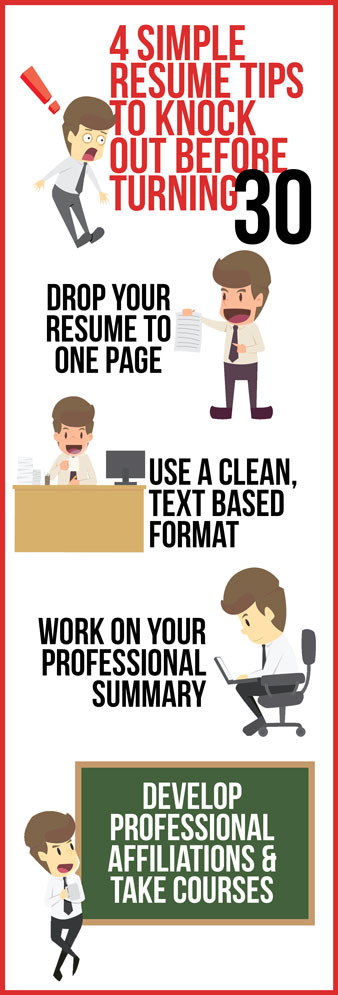
Your twenties is a pivotal time when setting up a foundation that could potentially blossom into a lucrative and rewarding career. While many young job seekers spend their twenties job hopping and finding their rightful place in the workforce, top performers in their industry gain momentum by choosing positions that will allow them to acquire the proper experience and develop relevant professional accomplishments. Great accomplishments and career growth in your twenties can be all for nothing if it is not presented properly. To assure that you have the best professional resume design optimized for your thirties, use these 4 simple resume tips to set you up for success.
1. Drop Your Resume To One Page
Before the age of 30, it is common to have anywhere between 1 to 10 years of experience to write about. This means that a simple one-pager will be best suited to represent your professional skills and development through the course of your career. One of the most important reasons behind using a one-page document is to keep the resume simple and diminish the possibility of being passed on by hiring managers that sift through hundreds of applications.
It is important to remember that hiring managers are looking to find the right candidate during their search that will fill the position with precision within a small time frame. A short and basic design loaded with valuable information are always sought out by recruiters and hiring managers. Be concise in your basic resume writing and highlight your best accomplishments in one page.
2. Use A Text-Based Simple Resume Format
Although the idea of a heavily stylized simple resume design may seem enticing, statistics show that these graphics-driven simple resume designs do not perform well against applicant tracking systems (ATS). Applicant tracking systems assist human resources and recruitment efforts by strategically pulling candidate background information into specific fields in a specific order.
Applicant tracking systems significantly decrease the amount of time it takes to successfully hire someone for a role by filtering out basic resumes that are not a match. Research performed by Jobscan has shown that 98.2% of Fortune 500 companies implement applicant tracking systems in their hiring processes. According to a Kelly OCG survey, it is estimated that 66% of large organizations and 35% of small organizations rely on ATS software to effectively screen applicants.
Don’t risk losing out on a position because your writing is not parsing properly into ATS. Skip the creativity and devote time to preparing the content of your writing as well as ensuring that you are using a clean, text-based format. Resumes that work seem to focus on your technical skills and professional accomplishments to help hiring managers see your value immediately. Keep in mind that this also doesn’t mean your resume design needs to be bland. Check out how our Simple Resume Design Team has optimized formatting for the modern-day job market by downloading our sample.
3. Work On Your Professional Summary
A professional summary is a short description at the beginning of your professional resume format that briefly details your title, experience, and skills. A succinct and attractive professional summary that provides hiring managers with a snapshot of your skills, background, and technical abilities is the best way to start.
Recruiters typically only spend roughly 6-7 seconds to read an applicant’s writing and will only look to read the professional summary before scanning for your current position and company. For this reason alone, it is highly important to invest time and energy into getting your professional summary well-developed. Optimizing your content to immediately detail your career accomplishments within the initial 6-7 second scan is critical.
4. Develop Professional Affiliations And Take Courses
Your twenties should consist of engaging in activities to invest in your professional network and skills. It is beneficial to consistently attend professional networking events to network and make professional connections even prior to looking for a new position. Build relationships and consistently follow up with your connections. At the end of the day, you never know who you might know that will have opportunities for you to take in the future.
Start by affiliating yourself with working professionals who share the same ideals and aspirations. This has been proven to open the door to many employment opportunities for young working professionals. Seek to join industry-related groups through social networking sites such as Twitter and Facebook and attend trade shows and conferences.
While you are building your professional network, look to pursue additional education and training in specialized courses. Use any opportunity to further educate yourself to help take your professional skills to another level. By doing so, this will work to separate you from fellow job candidates by proving that you’re driven, motivated, and eager to better yourself.
